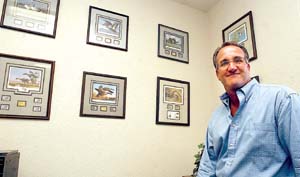Temperatures this September have been close to record breaking,
but residents soon can turn the air conditioner off high as the
mercury drops with each passing day, according to weather
forecasters.
Hollister – Temperatures this September have been close to record breaking, but residents soon can turn the air conditioner off high as the mercury drops with each passing day, according to weather forecasters.
The official temperature, taken from Southside Elementary School, topped 100 degrees on Monday – only two degrees shy of 1957’s scorching 102 degrees for that day, according to forecaster Bob Benjamin of the National Weather Service in Monterey.
Record highs for this day were reached in 1944 when it was 109 degrees. Benjamin said today’s temperatures are in the mid-90s, but added the heat should start gradually decreasing as the weekend approaches.
“It will still be warm by anybody’s standards, but each day should be a few degrees cooler,” he said. “By the weekend, it should be back to the typical upper 70s to 80s.”
The heat wave started around Friday, which reached 87 degrees. Temperatures increased by five degrees on Saturday and hit 99 on Sunday, Benjamin said.
The normal temperature for this time of year is about 83 degrees. A high pressure system over the state has suppressed the sea breeze causing temperatures to be 15 degrees higher than normal, he said.
“Without the sea breeze, the air conditioner is essentially turned off, allowing the maximum heating from the sun,” Benjamin said. “It’s gradually getting turned on, but it won’t be up to full blast until Friday or Saturday.”
Besides being uncomfortable for people, the heat is hard on the area’s foliage, said Ron Terry, manager of El Modeno Gardens, Inc.
Even with constant watering, the leaves of plants can get burned and growth can be slowed from the fiery temperatures, Terry said.
But as long as the heat wave breaks within a week, no major damage should occur, he said.
“It’s probably harder on people than on the plants,” Terry said.
Another uncomfortable side effect of the heat is the one it has on the nursery’s pocketbook. Its water bill increases at least $100 per day when it’s extremely hot, he said.
“We use quite a bit of water – over a quarter-million gallons of water a day,” Terry said. “Basically, when it’s hot we’re running water 24 hours a day.”
People should water their plants more during heat spells, but should go back to a normal watering cycle as soon as the temperatures decrease, he said.
The heat wave hasn’t resulted in an increase in heat-related complaints at Hazel Hawkins Hospital, said Marian Anderson, director of the emergency department.
Keeping out of the heat and the sun and keeping hydrated during especially hot days is imperative to staying healthy, Anderson said.
The elderly and very young are most affected by the heat, and they should take extra precautions, she said.
“It can sneak up on you if you’re not paying attention or replacing water,” she said. “It seems so simple and we tell people to drink water, but sometimes they don’t.”
Dehydration can leave people feeling light-headed, fatigued, nauseous or “just not like yourself,” Anderson said.
Usually Hollister’s location, with its proximity to the marine layer at the coast, keeps it from experiencing temperatures that are more common in the Central Valley during the summer and early fall, he said.
Late summer and early fall is when most of Hollister’s record high temperatures occur, said Benjamin. It’s the time of year when the wind flow is from the land to the ocean, versus the traditional flow from the ocean onto the land, which keeps temps cooler, he said.
While temperatures will remain constant in the mid-80s throughout October, the Labor Day weekend heat wave won’t be the last until it starts to cool off for good, Benjamin said.
“We’ll likely see at least another couple between now and mid-October,” he said. “(Temperatures) in the 100s or right below the century mark once or twice more would certainly not be out of the question.”









